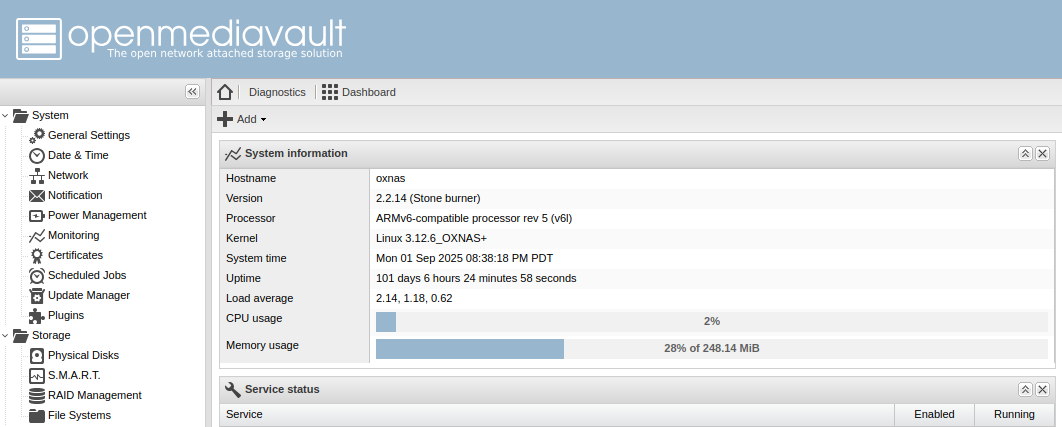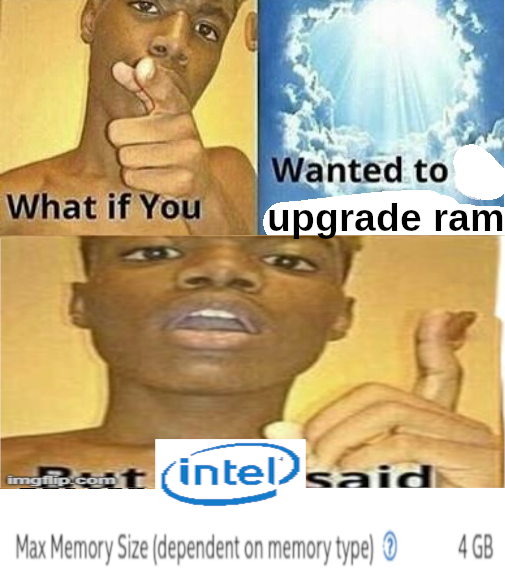Fuck ive been dealing with that + max RAM speed limitations for a month.
Selfhosted
A place to share alternatives to popular online services that can be self-hosted without giving up privacy or locking you into a service you don't control.
Rules:
-
Be civil: we're here to support and learn from one another. Insults won't be tolerated. Flame wars are frowned upon.
-
No spam posting.
-
Posts have to be centered around self-hosting. There are other communities for discussing hardware or home computing. If it's not obvious why your post topic revolves around selfhosting, please include details to make it clear.
-
Don't duplicate the full text of your blog or github here. Just post the link for folks to click.
-
Submission headline should match the article title (don’t cherry-pick information from the title to fit your agenda).
-
No trolling.
Resources:
- selfh.st Newsletter and index of selfhosted software and apps
- awesome-selfhosted software
- awesome-sysadmin resources
- Self-Hosted Podcast from Jupiter Broadcasting
Any issues on the community? Report it using the report flag.
Questions? DM the mods!
Testing federation from my shit hardware.. 😅
Not seeing other comments.. but see this over at .world

N...not quite...
I moved from a Drll R710 with dual docket Xeons to a rack mount desktop case with a single Ryzen R5 5600G. I doubled the performance and halved the power consumption in one go. I do miss having idrac though. I need a KVM over IP solution but haven't stomached the cost yet. For how often I need it it's not an issue.
Look for a processor for the same socket that supports more RAM and make sure the Motherboard can handle it - maybe you're lucky and it's not a limit of that architecture.
If that won't work, breakup your self-hosting needs into multiple machines and add another second hand or cheap machine to the pile.
I've worked in designing computer systems to handle tons of data and requests and often the only reasonable solution is to break up the load and throw more machines at it (for example, when serving millions of requests on a website, just put a load balancer in front of it that assigns user sessions and associated requests to multiple machines, so the load balancer pretty much just routes request by user session whilst the heavy processing stuff is done by multiple machines in such a way the you can just expand the whole thing by adding more machines).
In a self-hosting scenario I suspect you'll have a lot of margin for expansion by splitting services into multiple hosts and using stuff like network shared drives in the background for shared data, before you have to fully upgrade a host machine because you hit that architecture's maximum memory.
Granted, if a single service whose load can't be broken down so that you can run it as a cluster, needs more memory than you can put in any of your machines, then you're stuck having to get a new machine, but even then by splitting services you can get a machine with a newer architecture that can handle more memory but is still cheap (such as a cheap mini-PC) and just move that memory-heavy service to it whilst leaving CPU intensive services in the old but more powerful machine.
The beauty of self hosting is most of it doesn't actually require that much compute power. Thus, it's a perfect use for hardware that is otherwise considered absolutely shit. That hardware would otherwise go in the trash. But use it to self host, and in most cases it's idle most of the time so it doesn't use much power anyway.
I just upgraded to a Xeon E5 v4 processor.
I think the max RAM on it is about 1.5 TiB per processor or something.
It's not new, but it's not that old either. Still cost me a pretty penny.
Does this count ARMv6 256MB RAM running OpenMediaVault...hmm I have to fix my clock. LOL

Not anymore. My main self-hosting server is an i7 5960x with 32GB of ECC RAM, RTX 4060, 1TB SATA SSD, and 6x6TB 7200RPM drives.
I did used to host some services on like a $5 or $10 a month VPS, and then eventually a $40 a month dedi, though.
What do you use the 4060 for?
I use it for Plex/Jellyfin, it's the cheapest NVIDIA GPU that supports both AV1 encoding and decoding, even though Plex doesn't support AV1 yet IIRC it's still more futureproof that way. I picked it up for like around $200 on a sale, it was well worth it IMO.
Yeah, not here either. I'm now at a point where I keep wanting to replace my last host thats limited to 16GB. All the others - at least the ones I care about RAM on - all support 64GB or more now.
64GB would be a nice amount of memory to have. I've been okay with 32GB so far thankfully.
I run a local LLM on my gaming computer thats like a decade old now with an old 1070ti 8GB VRAM card. It does a good job running mistral small 22B at 3t/s which I think is pretty good. But any tech enthusiast into LLMs look at those numbers and probably wonder how I can stand such a slow token speed. I look at their multi card data center racks with 5x 4090s and wonder how the hell they can afford it.
I'm still interested in Self-Hosting but I actually tried getting into self-hosting a year or so ago. I bought a s***** desktop computer from Walmart, and installed window server 2020 on it to try to practice on that.
Thought I could use it to put some bullet points on my resume, and maybe get into self hosting later with next cloud. I ended up not fully following through because I felt like I needed to first buy new editions of the server administration and network infrastructure textbooks I had learned from a decade prior, before I could continue with giving it an FQDN, setting it up as a primary DNS Server, or pointing it at one, and etc.
So it was only accessible on my LAN, because I was afraid of making it a remotely accessible server unless I knew I had good firewall rules, and had set up the primary DNS server correctly, and ultimately just never finished setting it up. The most ever accomplished was getting it working as a file server for personal storage, and creating local accounts with usernames and passwords for both myself and my mom, whom I was living with at the time. It could authenticate remote access through our local Wi-Fi, but I never got further.
Hard to understad why it was difficult. For some reason windows admins are afraid of experimenting, breaking things. Practically I became sys admin by drinking beer and playing with linux, containers, etc.
My home server runs on an old desktop PC, bought at a discounter. But as we have bought several identical ones, we have both parts to upgrade them (RAM!) as well as organ donors for everything else.
7th gen intel, 96GB mismatched ram, 4 used 10TB HDD, one 12 with a broken sata connector that only works because it's sitting just right in a sled. A couple of 14's one M.2 and two sataSSD. It's running Unraid with 2 VM's (plex and Home Assistant), one of which has corrupted itself 3 times. A 1080 and a 2070.
I can get several streams off it at once, but not while it's running parity check and it can't handle 4k transcoding.
It's not horrible, but I couldn't do what I do now with less :)
Running a bunch of services here on a i3 PC I built for my wife back in 2010. I've since upgraded the RAM to 16GB, added as many hard drives as there are SATA ports on the mobo, re-bedded the heatsink, etc.
It's pretty much always ran on Debian, but all services are on Docker these days so the base distro doesn't matter as much as it used to.
I'd like to get a good backup solution going for it so I can actually use it for important data, but realistically I'm probably just going to replace it with a NAS at some point.
A NAS is just a small desktop computer. If you have a motherboard/CPU/ram/Ethernet/case and a lot of SSDs/HDDs you are good to go.
Just don't bother to buy something marketed as NAS. It's expensive and less modular than any desktop PC.
Just my opinion.
It's not absolutely shit, it's a Thinkpad t440s with an i7 and 8gigs of RAM and a completely broken trackpad that I ordered to use as a PC when my desktop wasn't working in 2018. Started with a bare server OS then quickly realized the value of virtualization and deployed Proxmox on it in 2019. Have been using it as a modest little server ever since. But I realize it's now 10 years old. And it might be my server for another 5 years, or more if it can manage it.
In the host OS I tweaked some value to ensure the battery never charges over 80%. And while I don't know exactly how much electricity it consumes on idle, I believe it's not too much. Works great for what I want. The most significant issue is some error message that I can't remember the text of that would pop up, I think related to the NIC. I guess Linux and the NIC in this laptop have/had some kind of mutual misunderstanding.
Solid. My backup is a T440p, and behind that a X230, fucking bulletproof.
Yeah, absolutely. Same here, I find used laptops often make GREAT homelab systems, and ones with broken screens/mice/keyboards can be even better since you can get them CHEAP and still fully use them.
I have 4 doing various things including one acting as my "desktop" down in the homelab. But they're between 4 and 14 years old and do a great job for what they're used for.
@ripcord @GnuLinuxDude The lifecycle of my laptops:
- years 1-5: I use them.
- years 5-10: my kids use them (generally beating the crap out of them, covering them in boogers/popsicle juice, dropping them, etc).
- years 10-15: low-power selfhosted server which tucks away nicely, and has its own screen so that when something breaks I don't need to dig up an hdmi cable and monitor.
EDIT: because the OP asks for hardware: my current backup & torrent machine is a 4th gen i3 latitude e7240.
I used to selfhost on a core 2 duo thinkpad R60i. It had a broken fan so I had to hide it into a storage room otherwise it would wake up people from sleep during the night making weird noises. It was pretty damn slow. Even opening proxmox UI in the remotely took time. KrISS feed worked pretty well tho.
I have since upgraded to... well, nothing. The fan is KO now and the laptop won't boot. It's a shame because not having access to radicale is making my life more difficult than it should be. I use CalDAV from disroot.org but it would be nice to share a calendar with my family too.
